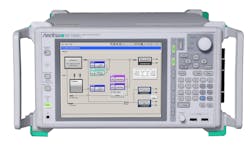Anritsu Co. says it has added clock recovery options to its MP1800A signal quality analyzer (SQA) to expand the analysis capability of the bit error rate tester (BERT) in high-speed interconnect design applications. Integrating the clock recovery options into the MP1800A enables signal integrity engineers to use a single test and measurement instrument to conduct highly accurate bit error rate (BER) measurements and jitter tolerance tests on SerDes, active optical cables (AOCs), and optical transceiver modules used in next-generation networks operating at speeds of 400 Gbps, the company claims. Traditionally, BER and jitter tolerance measurements of high-speed communications systems required external clock recovery instruments, Anrtisu asserts. The new internal clock recovery options in the MP1800A create a one-instrument tester that reduces the cost of test, occupies less bench space, and improves accuracy. The new capability complements existing support of BERT and jitter measurements up to 32 Gbps, as well as signal integrity analyses for various applications, including 100 Gigabit Ethernet (100G Base CR4 or KR4), InfiniBand EDR, CEI-28G, and 32G Fibre Channel. The MP1800A SQA is a modular-type BERT composed of an internal pulse pattern generator (PPG) and high-input-sensitivity error detector (ED) module, each of which can be configured with one, two, or four channels to support multi-channel synchronization of up to eight channels at 32 Gbps. A jitter modulation source can also be installed in the BERT to generate various types of jitter, including SJ, RJ, BUJ, and SSC, for device jitter tolerance tests. The plug-in modular design allows users to configure the MP1800A BERT to meet current test needs, with the flexibility to add measurement capability as needed, Anritsu says. Low jitter high-quality waveforms are achieved with the MP1800A, according to Anritsu. The PPG has good output signal quality; tunable output amplitude over a wide range for adjusting signal output amplitude; and tunable data output phase. The ED has high input sensitivity of 10 mV. Up to 3.5 Vp-p output amplitude is achieved, enabling the tester to power a direct-drive EML. For more information on test equipment and suppliers, visit the Lightwave Buyer’s Guide.
Want to learn more about test innovation? Attend the Lightwave Optical Innovation Summit
The Lightwave Optical Innovation Summit will feature panels and presentations that will illuminate where optical innovation is required in carrier and enterprise/data center networks, what it should look like, and when it might appear. A wide range of experts from the user, technology development, academic, and analyst communities will offer their views on innovation in a variety of areas, including test and measurement. Find out more about the Summit, which will be held in Austin, TX, July 14-16, at the Lightwave Optical Innovation Summit website.
